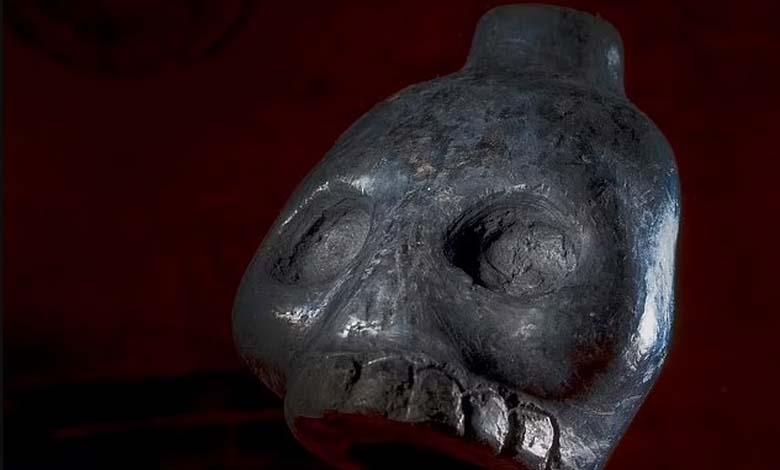The World’s Most Terrifying Sound: The Aztec “Death Whistle” Baffles Scientists

A recent study found that the ancient Aztec “Death Whistle” is as terrifying to modern audiences as it was 500 years ago. Described as “the most frightening sound in the world,” this chilling noise ranges from a harsh gust of wind to “the screams of a thousand corpses.”
-
Has Noah’s Ark Been Discovered? A 3,000-Year-Old Map Sparks Controversy
-
More than a year after its wreck… Design flaw discovered in the Titan
Researchers from the University of Zurich played the sound of the “Aztec Death Whistle” to a group of volunteers and recorded their brain responses, according to The Daily Mail.
They discovered that the whistle’s tones activate various higher-order brain centers, triggering an unusual sense of fear and anxiety.
A Sense of Fear
Participants who heard the sound reported feeling frightened. Brain scans revealed that the noise puts listeners in a state of heightened alertness, activating neural areas associated with basic emotions like anger, fear, and sadness.
-
A tree in Brazil that was believed to have gone extinct 185 years ago has been discovered
-
A mummy over 3,000 years old discovered in Peru
According to researchers, it’s no surprise that the Aztecs used these whistles to enhance religious rituals and sacrifices. This Mesoamerican civilization also used the “disturbing sound” to instill fear in their enemies during warfare.
The Aztec Death Whistle
Known as “Death Whistles” or “Skull Whistles,” these unique musical instruments were found at burial sites dating from 1250 to 1521 CE. Their skull-like design puzzled archaeologists for years until a brave researcher blew into one. The resulting sound was a piercing scream reminiscent of a human cry.
-
They wanted to clean the house, but they discovered the ‘hidden treasure’
-
A giant sea monster discovered in Morocco: an animal that devoured everything it saw
Terrifying the Enemy
Archaeologists remain uncertain about the exact purpose of these unusual tools. Some suggest they were used to intimidate enemies in battle or as part of human sacrifice rituals.
To learn more, scientists tested the reactions of modern listeners unfamiliar with the sound of the Aztec Death Whistle.
Professor Frohholz explained: “Since the sound of the Aztec Skull Whistle resembles human screams, we wanted to investigate whether humans today respond with the same negative, instinctive reaction.”
-
Archaeologists Find 6,000-Year-Old Ceramic Fragment
-
“Astonishing” Discovery during the Dissection of Mummified Hands in Peru
Recordings of original Aztec whistles, exact replicas, and custom-made whistles, along with various other recorded sounds, were played for a group of European participants.
The participants were then asked to describe what they heard and how it made them feel, while their brain activity was recorded using fMRI (functional magnetic resonance imaging).
Intense Reactions
In nearly all cases, the sound evoked a strong negative emotional response, accompanied by a sense of urgency and excitement. The researchers found that the effect on listeners was similar to that of firearms, sirens, angry shouts, or cries of pain or fear.
-
Mansoura University Enters Guinness World Records with the Discovery of “Tutcetus” Fossil
-
The Cosmic “Hot Dog” Dashes Hopes of Finding Extraterrestrial Civilizations
Imitating Natural Sounds
The researchers theorize that the “Death Whistle” may have been designed to mimic natural sounds like screams, reproducing their psychological impact on listeners.
By analyzing the sound spectrum of various whistles, they identified abrasive and noisy characteristics commonly found in “scary music.”
However, participants also likened the sound to artificial noises such as kettles, saws, or trains.
In their study published in Communications Psychology, the researchers suggest that this unusual mix of natural and artificial sounds might explain why the whistle is so terrifying.
-
Egypt: Archaeological Discovery Includes a Sword of Ramses and Weapon Depots
-
“Mysteries and Secrets” of a Plane 17 Years After Its Disappearance
Brain Confusion
Professor Frohholz added: “Through fMRI, we discovered that these sounds are both emotional and abstract in nature, activating associative mechanisms in the brain.”
When listeners hear the Death Whistle, it triggers a surge of activity in the brain’s auditory processing areas, momentarily leaving the brain confused.
The Aztecs may have exploited this disorienting effect as a means to strike fear, whether in approaching enemy armies or groups of worshippers during sacrificial rituals.
-
260 “Identical” Dinosaur Footprints Found in These Two Countries
-
10 Billion-Year-Old Stars from the Outskirts of the Universe Approach Earth
A Ritual Interpretation
Given its terrifying nature, the Death Whistle might have been used in warfare. However, Professor Frohholz and his team favor a ritual interpretation.
These whistles were found in the hands of sacrificial victims at temples such as the one dedicated to Ehecatl-Quetzalcoatl in Mexico City.
Similarly, the skull imagery on these instruments may represent Mictlantecuhtli, the Aztec lord of the underworld.
In their paper, the researchers conclude: “Considering the grotesque/terrifying nature of the sounds, the archaeological burial sites associated with rituals, and their likely use in ceremonies tied to the dead, a ritual context is highly probable.”
-
“The Longest Journey”: A turtle takes 31 years to return to its starting point
-
“My Husband Tied Me to a Tree”: American Woman Sparks Controversy in India
-
Discovery of the Method Used by Ancient Iraqis to Predict Disasters and Epidemics












